Who's idea was it to take a 7:15am Transavia flight from Eindhoven to Barcelona?
Starting the New Year off right with a trip to Barcelona
Jackie finally got Brooklyn to nap in her lap on the plane
The sky view on the way to Barcelona
We took a 30 minute Aerobus ride into Plaça de Catalunya
We grabbed some coffees and pastries from Cafe Zurich to start our day in Barcelona
We dropped our luggage off at a storage locker place until we could check into our Airbnb apartment.
We walked down Les Ramblas
Reial Academia de Ciencies i Arts de Barcelona
Mercado de La Boqueria, a large public market closed for the New Years holiday but definitely worth coming back to for a visit
Chinese dragon holding lantern decorates former umbrella shop & symbolizes Catalan pride to patron saint St Jordi (George)
Nice corner window
Liceu Opera House (Gran Teatre del Liceu)
Columbus Monument
Waterfront
Nikki in Barcelona
We got some gelato and then empandas from Catalan assorted street food vendors near the waterfront.
Next we walked over to the Basilica of Santa Maria del Mar, a 14th-century church that is the proud centerpiece of El Born.
On the big front doors of the Basilica of Santa Maria del Mar, notice the figures of workers who donated their time and sweat to build the church. The stone for the church was quarried at Montjuïc and had to be carried across town on the backs of porters called bastaixos.
The Basilica of Santa Maria del Mar interior is largely unadorned Gothic without the more highly decorated with Baroque frills. The Franco people burned all of its wood furnishings and decor (carbon still blackens the ceiling). Today the church remains stripped down— naked in all its Gothic glory. The tree-like columns inspired Gaudí.
Sculpture in El Born
Next we walked over to the Cathedral (Catedral de Barcelona).
Brooklyn walking around in front of the Catedral de Barcelona
We went to Xaloc for lunch for tapas: oxtail & mashed potatoes, roast meat canolini, huevos potatos, meat & cheese plate, and tomato bread.
After lunch it was time to to check-in at our airbnb apartment.
Walking to streets of Barcelona
We went to retrieve our luggage from the storage locker.
The apartment was about a 4 block walk northwest of Plaça de Catalunya, on Carrer d'Enric Granados.
Brooklyn was extremely overtired. She had barely fallen asleep in the stroller when we got to the apartment and she woke back up. We setup her travel tent to put her down for a nap. She was not adjusting well to the new surroundings.
Momma had to go in and stroke her hair and sing her to sleep. She got in some good snuggle time on mommy's belly with her little baby brother or sister growing in there.
Joe and Nikki went to the grocery store.
We ate dinner at nearby Vinitus: pork belly, anchoives, octopus, grilled cuttlefish, potatoes in spicy sauce, fried artichoke, grilled shrimp, and dessert of chocolate, ice cream, and cheese with raspberries.
We gave Brooklyn a bath and put her to bed for the night in her travel tent.
Although we were in town for first Sunday when the Picasso Museum had a free day, we decided to pay for timed tickets and bypass the long lines to this incredibly popular museum.
We had 9:20am tickets to the Picasso Museum. Brooklyn was ready for a nap by the time we got there. We ditched the stroller since she was way too whiny to be in a museum full of people listening to their audio guides. Jackie put her in the Ergo and rocked her until she finally fell asleep.
This is the best collection in Spain of the work of Spaniard Pablo Picasso (1881-1973). Since Picasso spent his formative years (from age 14-23) in Barcelona, it’s the best collection of his early works anywhere. The Picasso Museum’s collection of nearly 300 paintings is presented more or less chronologically. The artworks are scattered through several connected Gothic palaces, five mansions laced together.
Interior courtyard of one of the old mansions that houses the Picasso Museum
We spent about an hour in the Picasso Museum.
Since we had to rush out to the door this morning to make it to the museum in time, we picked up some coffees and bakery items around the corner in El Born. We still had some time to kill so we walked over to the Santa Caterina Market, the lesser known place to buy jamón and cheese without the crowds or tourist markup you get in La Boqueria. The Santa Caterina Market was built on the ruins of an old monastery, renovated in 2006 with a swooping roof and shell built around its original white walls. Now that is a lot of kinds of tomatoes
We met up with Emmita and Marcos for lunch but had some time to kill before the lunch spot opened up. We walked around the neighborhood a bit.
We walked through El Born Cultural Center (El Born Centre Cultural), which occupies the cast-iron structure of a 19th-century market. El Born Cultural Center is a multipurpose space that hosts an active medieval archaeological site.
Emmita was Jackie's friend from college at the NCSU Design School. She was a landscape design major but roommates with one of her good architecture friend's so they hung out a lot. Emmita moved to Spain a few years ago to teach English. She married Italian/Argentinian Marcos in Barcelona in 2011. We had just moved to Washington so we didn't have the free vacation time to make a big trip to Europe for the wedding. This visit was great because we got to have a lot of one and one time. Emmita is about 2 weeks ahead of Jackie in her pregnancy so it was nice to have someone in the same position going through withdrawls and cravings.
After lunch we walked around the Old City in El Born and Barri Gòtic.
Plaça del Rei where medieval buildings enclosed the square. The central section (topped by a five-story addition) was the core of the Royal Palace (Palau Reial Major), where in 1493 a triumphant Christopher Columbus, accompanied by six New World natives (whom he called “indios”) and several pure-gold statues, entered the Royal Palace. King Ferdinand and Queen Isabella rose to welcome him home and honored him with the title “Admiral of the Oceans.”
In Plaça del Rei to the right is the palace’s church, the 14th-century Chapel of Saint Agatha, which sits atop the foundations of a Roman wall.
In Plaça del Rei to the left is the Viceroy’s Palace (Palau del Lloctinent, for the ruler’s right-hand man).
Old buildings from Roman times
Roman Temple of Augustus (Temple Roma d’August) is tucked inside a small medieval courtyard. It has four columns from an ancient temple of Augustus which are a reminder of Barcelona’s Roman origins. The temple, dating from the late first century B.C., stood at one corner of the ancient forum quarter.
Plaça de Sant Jaume was the town’s central square, once a Roman forum, and now contains the local government buildings.
Carrer del Bisbe Bridge is reminiscent of Venice’s Bridge of Sighs. Made in the 1920s, it connects the Catalan government building (on the right) with what was the Catalan president’s ceremonial residence (on the left).
Cool old door
Cool old balcony railing
Plaça Sant Felip Neri with a baroque church in the Gothic Quarter with wounds etched in the facade of the 1938 bombing by fascist planes.
We shopped at a market in Plaça del Pi in front of the Basilica de Santa Maria del Pi.
La Boqueria Market is a covered lively market. Since 1200 it was located by medieval wall entrance (less expensive than trading within walls). It has a 1850 colonnade of an old monastery and an added colorful arcade with a stain-glass sign over the main entry.
mmm cured meats
The Iberian breed of pigs eat better than we do making it the best cured ham legs.
Afterwards we went to watch the futbol match between Barco and espanyol at a bar. It ended up being a tie, 0-0.
We parted ways with Emmita and Marcos.
We watched the light fountain show in Plaça de Catalunya.
We ate dinner at Son Hao, a Taiwanese restaurant near the apartment.
Before heading to Palau Güell to take advantage of the free first Sunday, we walked out of the apartment to the modernista icons in Eixample on Passeig de Gracia.
Casa Milà (La Pedrera) by Antoni Gaudí, nicknamed by "The Quarry"
Joe and Nikki weren't interested in going inside so we continued on to the Block of Discord.
Casa Batlló by Antoni Gaudí with its famous green-blue ceramic-speckled facade. It has tibia-like pillars and skull-like balconies. The tiled roof has an ice cream cone turret topped with a cross. The humpback ridgeline suggests a cresting dragon's back. The highlight of Casa Batlló is the roof with a fanciful dragon. There was already a long entry line.
Casa Amatller by Josep Puigi Cadafalch with a mix of Moorish-style pentagram and vine designs; Gothic-style tracery, gargoyles, and bay windows; and the step-gable roof from Spain's Habsburg connection to the Low Countries. There are many layers of the letter "A" on the house.
We took the metro down to the Liceu metro stop on the Ramblas for our next stop at the free Palau Güell.
The line to get tickets was about 20 people deep. It is usually €10 with an audioguide. The next available tickets weren't until 1:30. There was not a choice for a later time unless to wanted to go wait in line again. We had some time to kill around the Ramblas before we could enter the palace who's family name is pronounced "gway".We walked through Plaça Reial, a genteel-feeling square, with palm trees and a pair of Gaudí-designed lampposts.
Next we walked into the side cloister entrance to the Cathedral of Barcelona.
The Cathedral of Barcelona cloister is home to many swans
Cathedral of Barcelona cloister
It was Sunday so we could not get access into the side of the Cathedral of Barcelona from the cloister probably because mass was ongoing.
Cathedral of Barcelona cloister door
Brooklyn dancing to the Spanish music in front of the Cathedral of Barcelona
We all listened to an engaging 24-stop audioguide.
Palau Güell door to Coach House
Palau Güell Coach House ceiling
Neo-Gothic cellar in the basement, with its mushroom pillars, was used as a stable at Palau Güell
Palau Güell courtyard stables
Palau Güell window from Coach house down into courtyard off the stables
The Palau Güell parabolic-arch entryways and wrought-iron doors were cleverly designed so that those inside could see out, and light from the outside could get in-but not vice versa.
Palau Güell ground floor entrance vestibule
Palau Güell entrance staircase to mezzanine
Palau Güell wood and wrought iron grill door to the vestibule on the mezzanine floor
Palau Güell vestibule stained glass window representing the Catalan flag
Palau Güell vestibule marble ceiling
Palau Güell vestibule
Palau Güell mezzanine vestibule
Palau Güell main floor entrance staircase and antechamber
Palau Güell antechamber
Palau Güell antechamber stained glass window
Palau Güell wooden ceiling
Palau Güell corridor of glazed cathedral-type windows set in an iron lattice frame, designed by Gaudí.
Palau Güell hall of intimates
Palau Güell bay window room or smoking room
Palau Güell dining room
Palau Güell bay window exterior from southern terrace
Palau Güell courtyard off the stables from the southern terrace
Palau Güell southern terrace from the billard room
Palau Güell hall of lost steps arcade that overlooks the street and provides plenty of light
Momma admiring the front facade arcade full of light of Palau Güell while Brooklyn napped
Palau Güell hall of lost steps entry into the central hall
Palau Güell wood ceiling
Palau Güell visitors’ room and ladies' powder room
Palau Güell visitors’ room with its noteworthy ceiling, made from fine woods with wrought iron and gold leaf details
Palau Güell visitors’ room wooden wainscoting
Palau Güell Central Hall
Palau Güell Central Hall crowned by a parabolic dome with small openings in the oculus pouring in light
Palau Güell Central Hall closet chapel
Palau Güell Central Hall closet chapel door
Climbing the Central Hall stairs of Palau Güell
Palau Güell Central Hall organ pipes
Palau Güell Central Hall from the stairs
Jackie and sleeping Brooklyn in the overlooks of the Palau Güell Central Hall
Palau Güell musicians' gallery
Palau Güell Isabel López’s bedroom
Palau Güell Isabel Güell’s bedroom stained glass window depicting Macbeth and Hamlet
Palau Güell Eusebi Güell’s bedroom
Palau Güell bathrooms
Palau Güell Servants' staircase suspended from the roof
Palau Güell attic area
On the Palau Güell rooftop Gaudí slathered the 20 chimneys and ventilation towers with bits of stained glass, ceramic tile, and marble to create a forest of giant upside-down ice-cream cones.
Palau Güell rooftop central spire 15 meters high which atops the dome of the central hall and covered in original recycled stone
Jackie and Brooklyn reflected in the window on the rooftop of Palau Güell
Palau Güell rooftop railing
Palau Güell rear facade from the rooftop
Palau Güell main facade (note the wrought-iron doors that you can't see in from outside)
Palau Güell main facade
Our next stop was for a late afternoon paella at a recommended location on the beach. We took the metro and then had a 10-15 walk to Escriba. It usually has a long wait so we were hoping that arriving close to 3 with the restaurant closing between 5 and 8 that the off-hour would ease the crowds. We put our name on the list with a 25 minute wait.
Barcelona BeachWhile waiting for a table at Escriba, Brooklyn played in the sand on the beach.
The best paella at Escriba
Our next destination was the Maritime Museum, which was also free after 3pm on the first Sunday of the month.
Maritime Museum
Maritime Museum boats on exhibit
Next we took the metro back to 2 stops from the apartment so we could visit a Christmas Market (Fira de Reyes Gran Via between Carrer Muntaner and Carrer Entença, west of universitit metro station) on our walk back.
Joe and Nikki enjoyed some roasted chestnuts.
Monday Jan 4
Today we planned to take a daytrip out of the city of Barcelona to Montserrat, a Benedictine monastery in the rock pillar mountains with good hiking trails. Montserrat, means “serrated mountain”, with peaks that reach upward to 4,000 feet, erosion pocked the face with caves and cut vertical grooves near the top, creating the famous serrated look. The monastery is nestled in the jagged peaks at 2,400 feet, but it seems higher because of the way the rocky massif rises out of nowhere.
Today we planned to take a daytrip out of the city of Barcelona to Montserrat, a Benedictine monastery in the rock pillar mountains with good hiking trails. Montserrat, means “serrated mountain”, with peaks that reach upward to 4,000 feet, erosion pocked the face with caves and cut vertical grooves near the top, creating the famous serrated look. The monastery is nestled in the jagged peaks at 2,400 feet, but it seems higher because of the way the rocky massif rises out of nowhere.
We took the train from Plaça d'Espanya in Barcelona to Montserrat Aeri Station.
Next we got in line to take the Aeri de Montserrat cable car up to Montserrat.
Montserrat is on the top of the foggy cliff
Montserrat is on the top of the foggy cliff
Ready to board the cable car
The view back down from Montserrat
Montserrat cliffside
We ate some lunch at the cafeteria before walking around the monastery for a bit.
The Montserrat rock pillars as we walked up to the Basilica
Picasso sculpture at Montserrat
Basilica
Jackie and Brooklyn walking around the Montserrat Basilica courtyard
Picasso sculpture at Montserrat
Basilica
Jackie and Brooklyn walking around the Montserrat Basilica courtyard
Basilica interior
We discussed taking the Sant Joan funicular and hiking back down, but the cold and fog at the current elevation kept us from going further.
The view as we rode the cable car back down from Montserrat
The view of a hiking trail from the cable car ride from Montserrat
Selfie on the cable car from Montserrat
Other cable car riding up to Montserrat
After training back to Plaça d'Espanya, we walked to Sant Antoni for a flea market that was nothing worth noting since the large market building was under a construction.
Next we head to dinner at La Gardunya in the back of the La Boqueria Market.
We walked back up the Ramblas. This time Joe made sure to point out the black and gold fountain Jackie kept mentioning she's missed.
The Fountain of Canaletes legend is that one who drinks from the fountain ensures you will be back to Barcelona one dayWe walked a few blocks down the Christmas Market.
Tuesday Jan 5
We planned to take the L2 metro from Universitat to Sagrada Família, a 20 minute ride, but we were notified once we were below ground that the metro was not running to the Sagrada Família and that we should look for the M bus on the street level. Once it finally arrived, we crammed aboard to ride to the massive church just in time for entering under our pre-purchased tickets.
Basilica de la Sagrada Família (Holy Family Church) is designed by Antoni Gaudí, but is still under construction. It is known for its otherworldly spires. There are 4 steep 330-foot spires topped with crosses. When finished, the church will have a total of 18 spires. Four will stand at each of the 3 entrances.
The Nativity Facade is the only one finished in Gaudí's lifetime. It is the best example of Gaudí’s original vision, theme, which faces the rising sun, and illustrates Christ’s birth. The Nativity Facade expresses the birth of Jesus and recounts the main events in the lives of the Holy Family.
Sagrada Família Nativity Facade by Antoni Gaudí
Sagrada Família Nativity Facade Holy Family
Sagrada Família Nativity Facade Three Kings
Sagrada Família Nativity Facade Holy Family
Sagrada Família Nativity Facade Three Kings
Sagrada Família Nativity Facade entry door
Jackie and Nikki in front of La Sagrada Família Nativity Facade
Inside La Sagrada Família at the Nativity Facade entry
La Sagrada Família has a Latin cross plan, 300 feet long and 200 feet wide and 150 feet (45m) high central nave of 48,000 square feet which can accommodate 8,000 worshippers.
Like the trunks of trees, the columns (56 in all) blossom with life, complete with branches, leaves, and knot-like capitals. The columns are a variety of colors—brown clay, gray granite, dark-gray basalt. The taller columns are 72 feet tall; the shorter ones are exactly half that. There are 4 different types of columns with varying numbers of vertexes, diameters, and made of different stones. There are eight-pointed star-shaped columns supporting the central nave. It double twists so as the column grows in height, the faces and groins are duplicated. The angled columns form many arches, both parabolas (U-shaped) and hyperbolas (flatter, elliptical shapes). Gaudí’s starting point was the Gothic pointed arch used now at its best bearing weight.
La Sagrada Família tree-like column ceiling
The 4 red porphyry columns eventually will also support the central steeple, the 560-foot Jesus tower with the shining cross, and will be tallest church steeple in world. Crowning the highest tower will be a four-armed cross.
La Sagrada Família altar
Little windows let light filter in like the canopy of a rainforest, giving both privacy and an intimate connection with God.
La Sagrada Família side aisles
The splashes of color of the stained glass breathe even more life into this amazing space of La Sagrada Família.
The U-shaped choir is suspended above the nave and can seat 1,000 with 4 organs.
Sagrada Família stone spiral stair
Sagrada Família apse stain glass
In 2010, the main nave was finished enough to host a consecration Mass by Pope Benedict XVI.
Sagrada Família Glory Facade (front entry) is still to be built and will be the main one. It will tell of the origin and end of human beings.
Inside the church you can view a life-size image of the 5 meters tall bronze entry doors, emblazoned with the entire text of the Lord’s Prayer (Our Father) in Catalan, surrounded by “Give us this day our daily bread” in 50 languages. Gaudí purposely left the facade’s design open for later architects.
Inside the La Sagrada Família Glory Facade
Inside above the front entry of La Sagrada Família Glory Facade
Spiral stair on the front Sagrada Família Glory Facade
Inside looking at La Sagrada Família Passion Facade
Sagrada Família holy water basin at the entries
Metal door to stair in La Sagrada Família
The Nativity Facade elevator is more exciting but more demanding. You get the opportunity to cross the dizzying bridge between the towers, but you need to take the stairs all the way down. Jackie and Nikki had tickets for 10:30am, with entrance between 10 and 10:15 to go up the Nativity Tower. Joe stayed behind because children under the age 6 were not allowed.
There are 4 towers on the Nativity Facade. You take the elevator halfway up the south tower. You then take the spiral stairs up a little further. You can then cross the connecting bridge between the 2 pairs of towers. Then you descend the north tower stairs.
Selfie atop of the bridge of the Nativity Tower of La Sagrada Família
Selfie atop of the bridge of the Nativity Tower of La Sagrada Família
Looking up at one of La Sagrada Família Nativity Towers from the connecting bridge
Looking up at two of La Sagrada Família Nativity Towers from the connecting bridge
Fruit cones on La Sagrada Família Nativity Facade which mimic crystals found in minerals such as pyrite and fluorite
Gloria on La Sagrada Família Nativity Facade
A peek at the stain glass windows of La Sagrada Família Nativity Facade
View of north Barcelona toward the mountains from La Sagrada Família Nativity Tower
View of northeast Barcelona toward the mountains from La Sagrada Família Nativity Tower
A peek at the view platform of La Sagrada Família Nativity Tower
Sculptural piece at view platform of northeast Barcelona from La Sagrada Família Nativity Tower
View of east Barcelona toward the sea from La Sagrada Família Nativity Tower
View of southeast Barcelona toward the sea from La Sagrada Família Nativity Tower
Looking up at the Nativity Tower from the view platform on La Sagrada Família Nativity Tower
Looking down at the entry to La Sagrada Família Nativity Facade
Looking up La Sagrada Família Nativity Tower interior
View of La Sagrada Família Nativity Tower interior
Looking down La Sagrada Família Nativity Tower interior (I bet this is a sight to see lit up at night)
The spiral stair of La Sagrada Família Nativity Towers
Now I can see why children under 6 years old were not allowed.
Fruit cones on La Sagrada Família Nativity Facade which mimic crystals found in minerals such as pyrite and fluorite
Gloria on La Sagrada Família Nativity Facade
A peek at the stain glass windows of La Sagrada Família Nativity Facade
View of north Barcelona toward the mountains from La Sagrada Família Nativity Tower
View of northeast Barcelona toward the mountains from La Sagrada Família Nativity Tower
A peek at the view platform of La Sagrada Família Nativity Tower
Sculptural piece at view platform of northeast Barcelona from La Sagrada Família Nativity Tower
View of east Barcelona toward the sea from La Sagrada Família Nativity Tower
View of southeast Barcelona toward the sea from La Sagrada Família Nativity Tower
Looking up at the Nativity Tower from the view platform on La Sagrada Família Nativity Tower
Looking down at the entry to La Sagrada Família Nativity Facade
Looking up La Sagrada Família Nativity Tower interior
View of La Sagrada Família Nativity Tower interior
Looking down La Sagrada Família Nativity Tower interior (I bet this is a sight to see lit up at night)
The spiral stair of La Sagrada Família Nativity Towers
Now I can see why children under 6 years old were not allowed.
Looking up the spiral stair of La Sagrada Família Nativity Towers
Views into La Sagrada Família interior from the tops of the column height in the Nativity Tower
The non-descrip door Jackie came out of after she climbed down La Sagrada Família Nativity Tower
For the design of the capitals of the top of the towers on the 3 facades, Gaudí chose twinned polyhedrons, the result of the study of crystallization of minerals. Before he died, he was able to see the pinnacle of the bell tower on the Nativity Tower finished with colorful Venetian mosaics.
Views into La Sagrada Família interior from the tops of the column height in the Nativity Tower
The non-descrip door Jackie came out of after she climbed down La Sagrada Família Nativity Tower
For the design of the capitals of the top of the towers on the 3 facades, Gaudí chose twinned polyhedrons, the result of the study of crystallization of minerals. Before he died, he was able to see the pinnacle of the bell tower on the Nativity Tower finished with colorful Venetian mosaics.
La Sagrada Família Passion Facade tells the story of Christ’s torture and execution with bone-like archways. The Passion Facade, done in 1986 by Josep Maria Subirachs, represents the passion, death and resurrection of Jesus. This facade is meant to be grim and terrifying.
Sagrada Família Passion Facade doors
La Sagrada Família Schoolhouse was built by Gaudí for children of workers.
Sagrada Família Passion Facade doors
La Sagrada Família Schoolhouse was built by Gaudí for children of workers.
Planoids are curved surfaces generated by the movement of a straight line. They were first used by Antoni Gaudí. A conoid is a surface generated by the straight line resting on a curve and a straight and remaining parallel to a plane. The revolutionary parabolic roof can be seen on the School.
La Sagrada Família has an expected completion of 2026, the 100th anniversary of Gaudí death.
La Sagrada Família has an expected completion of 2026, the 100th anniversary of Gaudí death.
Bronze model of the completed Sagrada Família
Another model of the completed Sagrada Família (tan is currently done and ivory remains to be constructed with views from Nativity Facade, rear and front Glory Facade)
The crypt beneath the church holds the tomb of Gaudí. The museum in the crypt displays Gaudí’s original models and drawings, and chronicles the progress of construction over the last 130 years.
Another model of the completed Sagrada Família (tan is currently done and ivory remains to be constructed with views from Nativity Facade, rear and front Glory Facade)
The crypt beneath the church holds the tomb of Gaudí. The museum in the crypt displays Gaudí’s original models and drawings, and chronicles the progress of construction over the last 130 years.
It is amazing to see the original neo-Gothic church design of the original architect (Del Villar) before Gaudí took over after the crypt columns were constructed. It was so ordinary.
In Gaudí’s first design, it was still strongly Neo-Gothic but introduced the catenary arch
In the second design around 1914, Gaudí used a parabolic arch
In the third design around 1918, Gaudí used hyperboloids for several parts of the nave.
The construction photos from the early 1900s were a sight to see. Sorry photos of photos didn't turn out so great.
In Gaudí’s first design, it was still strongly Neo-Gothic but introduced the catenary arch
In the second design around 1914, Gaudí used a parabolic arch
In the third design around 1918, Gaudí used hyperboloids for several parts of the nave.
The construction photos from the early 1900s were a sight to see. Sorry photos of photos didn't turn out so great.
Model of La Sagrada Família Nativity Facade
Model of La Sagrada Família Passion Facade
Beautiful model detail
The massive model of the nave that you can literally walk under!
Model of the side aisle stain glass window
Another huge model of La Sagrada Família
Lots of 3D printing happening here, making the construction of this amazing church feasible
Geometry of the side aisle vaults, a forest of hyperboloids
The hyperboloid provides light with lanterns in the vaults
An inverted hanging model of the nave of La Sagrada Família
Another inverted hanging model
Drawing of La Sagrada Família Glory Facade
Drawing of La Sagrada Família Passion Facade
La Sagrada Família rear back apse exterior
We ate lunch at La Paradeta, a made to order seafood place with a long line out the door before they even opened
Our next stop for the day was Park Güell, a 30 acre foothills park. We walked north to grab a crowded bus to the park.
Model of La Sagrada Família Passion Facade
Beautiful model detail
The massive model of the nave that you can literally walk under!
Model of the side aisle stain glass window
Another huge model of La Sagrada Família
Lots of 3D printing happening here, making the construction of this amazing church feasible
Geometry of the side aisle vaults, a forest of hyperboloids
The hyperboloid provides light with lanterns in the vaults
An inverted hanging model of the nave of La Sagrada Família
Another inverted hanging model
Drawing of La Sagrada Família Glory Facade
Drawing of La Sagrada Família Passion Facade
La Sagrada Família rear back apse exterior
We ate lunch at La Paradeta, a made to order seafood place with a long line out the door before they even opened
Our next stop for the day was Park Güell, a 30 acre foothills park. We walked north to grab a crowded bus to the park.
Much of the park is free, but the part visitors want to see, the Monumental Zone—with all the iconic Gaudí features—has an entry fee and time-limited admission. The Monumental Zone costs €8 at the gate. The Monument Zone is limited to 400 visitors every 30 minutes. We got tickets for 16:30. We walked around the free access area of Park Güell until our appointed time.
Funded by his frequent benefactor Eusebi Güell, Gaudí intended this 30-acre garden to be a 60-residence housing project, a kind of gated community. Work began in 1900, but progress stalled in 1914 with the outbreak of WWI and the project never resumed.
Brooklyn chasing the pigeons in Park Güell
We climbed up high by Casa Trias for a bird’s-eye view of the park and city below.
Park Güell Casa Trias
Views of Barcelona from Park Güell
Sagrada Família from Park Güell
Park Güell Viaduct
The Park Güell main drag connecting the Gaudí House Museum to the terrace, called the Rosary Pathway, is lined with giant stone balls that represent the beads of a rosary. During the years he lived here, the reverent Gaudí would pray the rosary while walking this path.
Now time to enter the Park Güell Monument Zone...
We climbed up high by Casa Trias for a bird’s-eye view of the park and city below.
Park Güell Casa Trias
Views of Barcelona from Park Güell
Sagrada Família from Park Güell
Park Güell Viaduct
The Park Güell main drag connecting the Gaudí House Museum to the terrace, called the Rosary Pathway, is lined with giant stone balls that represent the beads of a rosary. During the years he lived here, the reverent Gaudí would pray the rosary while walking this path.
Now time to enter the Park Güell Monument Zone...
Entering Park Güell, you walk through a palm-frond gate and pass Gaudí’s gas lamps (1900-1914), both made of wrought iron. His dad was a blacksmith, and he always enjoyed this medium. Two Hansel-and-Gretel gingerbread lodges flank the entrance.
Park Güell two pavilions with roofs clad in trencadís (broken tile shards in a mosaic that are often taken rearranged from demolished materials and unused objects). We felt like we were entering between gingerbread houses.
Park Güell house to the left of the main entrance
Park Güell porter's lodge to the right of the main entrance
Park Güell monumental flight of stairs
Three fountains are stacked in the middle of the stairway . The first, at the base of the steps, is rocky and leafy, typical of Gaudí’s naturalism. Next is a red-and-gold-striped Catalan shield with the head of a serpent poking out. The third is a very famous dragon— an icon of the park (and of Barcelona). While the dragon— slain by Barcelona’s patron saint, George (Jordi)— is a symbol of Catalan pride, this creature also evokes the crocodile mascot of Nîmes, France, where Eusebi Güell spent much of his youth.
Park Güell two pavilions with roofs clad in trencadís (broken tile shards in a mosaic that are often taken rearranged from demolished materials and unused objects). We felt like we were entering between gingerbread houses.
Park Güell house to the left of the main entrance
Park Güell porter's lodge to the right of the main entrance
Park Güell monumental flight of stairs
Three fountains are stacked in the middle of the stairway . The first, at the base of the steps, is rocky and leafy, typical of Gaudí’s naturalism. Next is a red-and-gold-striped Catalan shield with the head of a serpent poking out. The third is a very famous dragon— an icon of the park (and of Barcelona). While the dragon— slain by Barcelona’s patron saint, George (Jordi)— is a symbol of Catalan pride, this creature also evokes the crocodile mascot of Nîmes, France, where Eusebi Güell spent much of his youth.
Selfie at Park Güell
Park Güell tiled railing
The cave-like enclosures flanking the Park Güell monumental stairs were functional: One was a garage for Eusebi Güell’s newfangled automobiles, while the other was a cart shelter.
A dragon or brightly colored salamander guards a whimsical staircase of Park Güell
Park Güell monumental stair bench
Looking back at the Park Güell entrance from the top of the monumental stair
Park Güell terrace lion's head gargoyle drainspouts
Gaudí engineered a water-catchment system by which rain hitting this plaza would flow through natural filters, then through the columns of the market below to a 300,000-gallon underground cistern. The water was bottled and sold as a health cure.
Park Güell tiled railing
The cave-like enclosures flanking the Park Güell monumental stairs were functional: One was a garage for Eusebi Güell’s newfangled automobiles, while the other was a cart shelter.
A dragon or brightly colored salamander guards a whimsical staircase of Park Güell
Park Güell monumental stair bench
Looking back at the Park Güell entrance from the top of the monumental stair
Park Güell terrace lion's head gargoyle drainspouts
Gaudí engineered a water-catchment system by which rain hitting this plaza would flow through natural filters, then through the columns of the market below to a 300,000-gallon underground cistern. The water was bottled and sold as a health cure.
The Park Güell terrace is supported by a forest of columns.
Park Güell Marketplace or Hypostyle Room or Columns Room of 86 striated columns inspired by the Doric order that could be used as a marketplace. This space was designed to house a produce market for the neighborhood’s 60 mansions.
Park Güell "Pathway of Columns" or portico of the washerwoman, an arcade of one of many clever double-decker viaducts that Gaudí designed for the grounds: vehicles up top, pedestrians in the portico down below.
Park Güell fence
Eusebi Güell lived in the pink house (now a school) next to the terrace.
Park Güell "Pathway of Columns" or portico of the washerwoman, an arcade of one of many clever double-decker viaducts that Gaudí designed for the grounds: vehicles up top, pedestrians in the portico down below.
Park Güell fence
Eusebi Güell lived in the pink house (now a school) next to the terrace.
Park Güell ramp
There are inviting, curvy benches along a spectacular terrace which offer free, sweeping panoramic views of Barcelona from the Park Güell terrace or Teatre Grec or Nature Theatre. The 360-foot-long bench is designed to fit your body ergonomically.
Looking back down at the Park Güell entrance from the terrace
As the sun began to set, we walked to the closest metro stop and took it to Plaça de Catalunya. We had some drinks and snacks at Cafe Zurich. Crowds had started to form waiting for the Epiphany Three Kings Day Parade or Día de los Reyes Magos. Although the Epiphany is on January 6, on the evening of the 5th the Three Wise Men arrive in Barcelona after a long journey from the FarEast and parade through the city streets on regal floats. In Spain, the three kings bring presents to the children so this is an even bigger day than Christmas.
There are inviting, curvy benches along a spectacular terrace which offer free, sweeping panoramic views of Barcelona from the Park Güell terrace or Teatre Grec or Nature Theatre. The 360-foot-long bench is designed to fit your body ergonomically.
Looking back down at the Park Güell entrance from the terrace
As the sun began to set, we walked to the closest metro stop and took it to Plaça de Catalunya. We had some drinks and snacks at Cafe Zurich. Crowds had started to form waiting for the Epiphany Three Kings Day Parade or Día de los Reyes Magos. Although the Epiphany is on January 6, on the evening of the 5th the Three Wise Men arrive in Barcelona after a long journey from the FarEast and parade through the city streets on regal floats. In Spain, the three kings bring presents to the children so this is an even bigger day than Christmas.
Brooklyn cheesin while sitting on the street curb waiting for the parade to begin
Jackie and Brooklyn watching the Epiphany Three Wise Men Parade
Daddy and Brooklyn watching the Epiphany Three Wise Men Parade
Epiphany Three Wise Men Parade
Children can deliver their present wishlists to the kings' pages and messengers in the parade.
Jackie and Brooklyn watching the Epiphany Three Wise Men Parade
Daddy and Brooklyn watching the Epiphany Three Wise Men Parade
Epiphany Three Wise Men Parade
Children can deliver their present wishlists to the kings' pages and messengers in the parade.
The first king Melchior has white hair and long beard.
Wednesday Jan 6
This morning we had breakfast at Brunch & Cake a block north of our Airbnb apartment.
We had a 2:15pm Transavia flight out of Barcelona. After checking out of the apartment, we walked to Plaça de Catalunya to catch the Aerobus to the airport.
Goodbye Barcelona, until next time
Goodbye Barcelona, until next time
























































































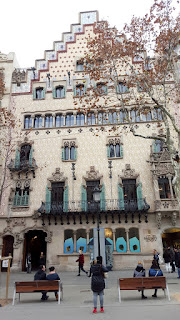
































































































































































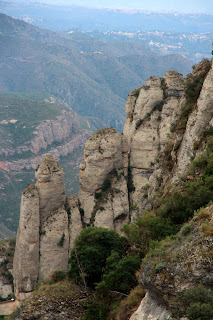





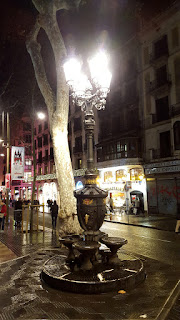

































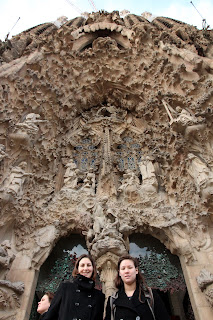

























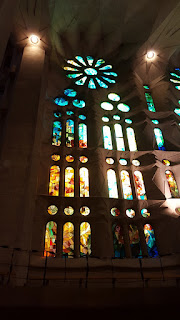










































































































































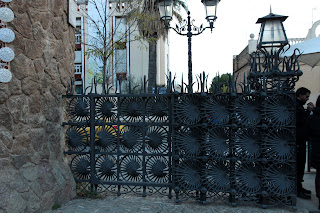














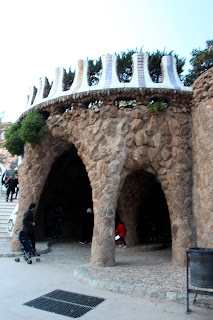














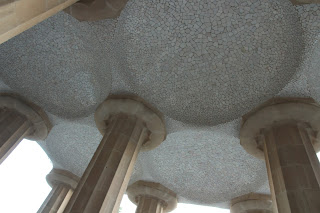
























































No comments:
Post a Comment